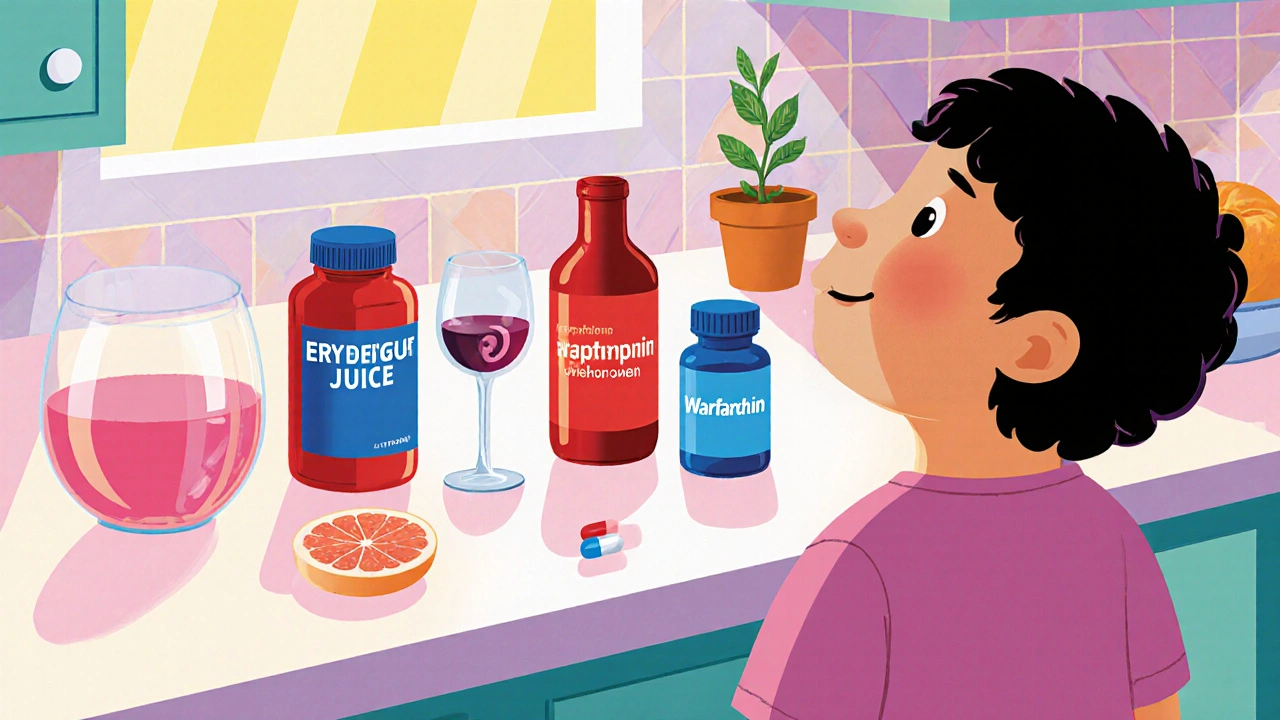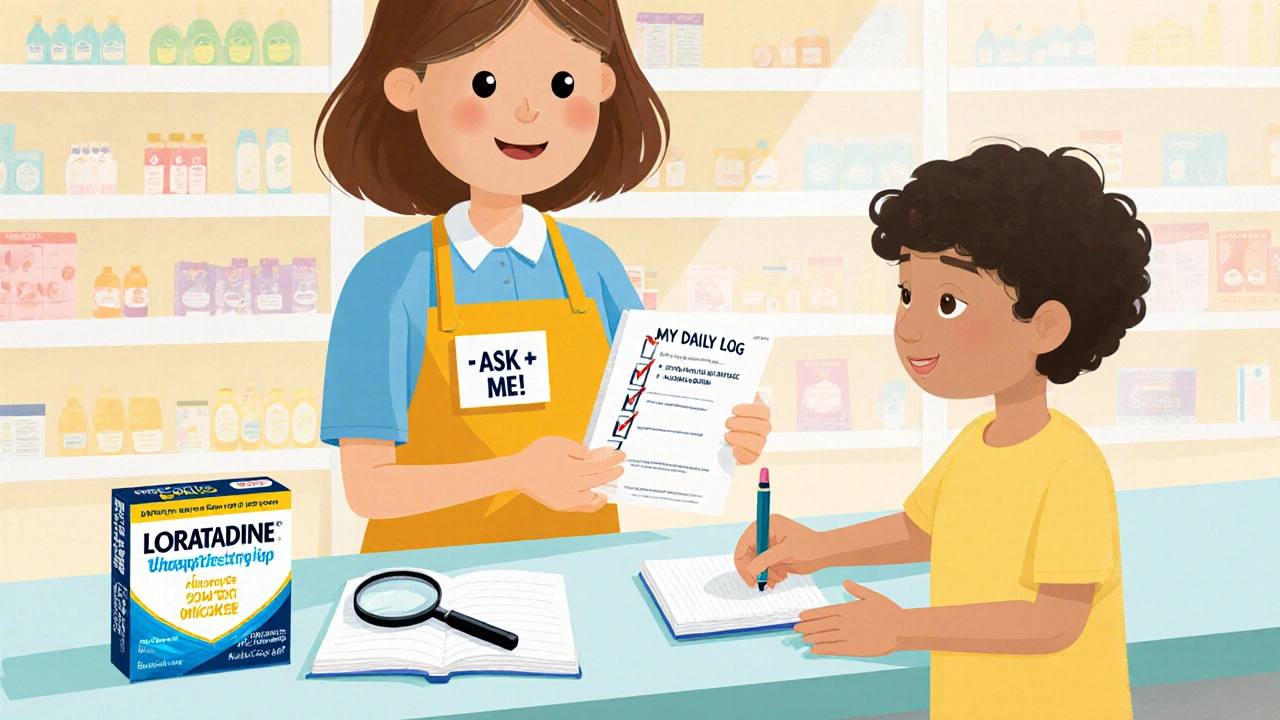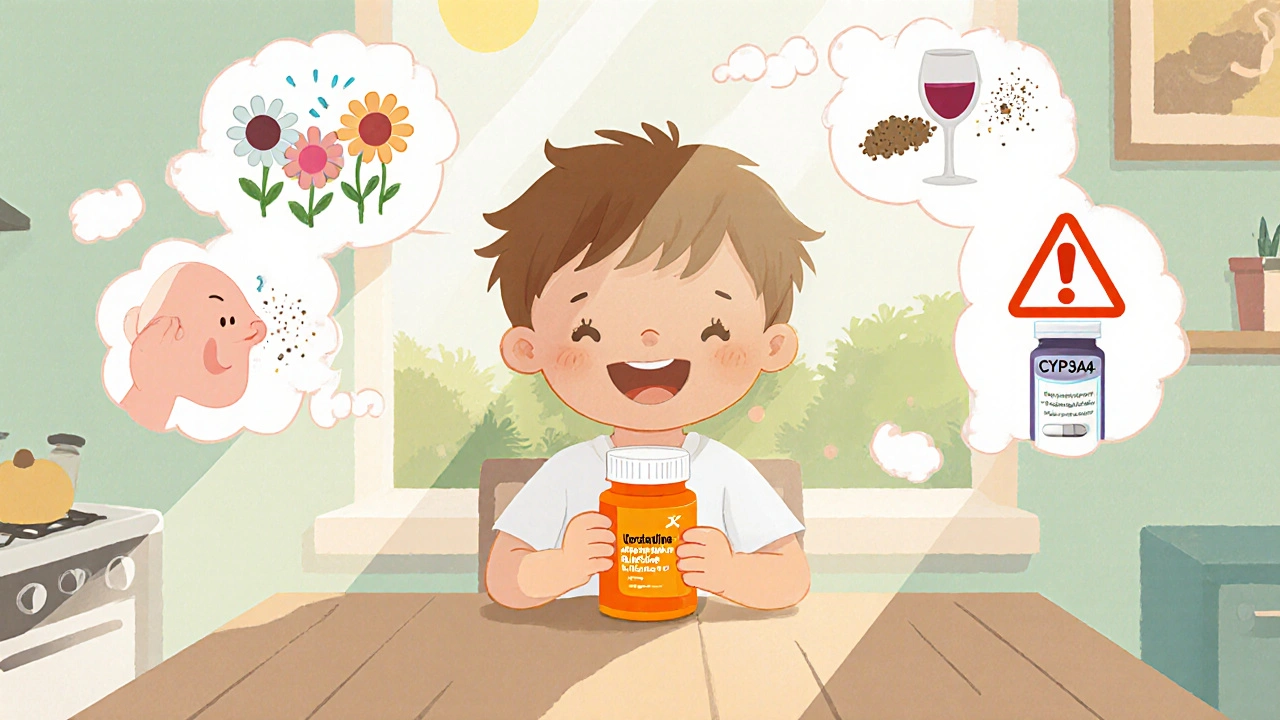When you reach for an over‑the‑counter antihistamine, you probably think about quick relief from sneezing, itchy eyes, or a runny nose. What you often overlook is how that same pill can play tag with other meds, foods, or even alcohol. loratadine interactions can turn a simple allergy fix into a headache, a drowsy afternoon, or a more serious health issue.
Quick Takeaways
- Never mix loratadine with strong CYP3A4 inhibitors like erythromycin or grapefruit juice.
- Avoid alcohol if you need to stay alert; the combo can heighten drowsiness.
- Watch out for sedating antihistamines (diphenhydramine, cetirizine) - they don’t add benefit and increase side‑effects.
- Coupling loratadine with certain blood thinners (warfarin) may change clot‑risk profiles.
- Always tell your pharmacist or doctor about any supplement, especially St. John’s Wort or pseudo‑ephedrine‑based decongestants.
Loratadine is a second‑generation antihistamine that blocks H1 receptors, reducing the body’s response to histamine without causing the heavy sedation seen in older antihistamines. First approved by the FDA in 1993, it’s become a staple for seasonal allergies, hives, and allergic conjunctivitis.
Why Interactions Matter
Loratadine’s chemistry is relatively stable, but it’s metabolized in the liver by the enzyme CYP3A4. Anything that slows down or speeds up this enzyme can change how much drug stays in your bloodstream. Too much loratadine can lead to headaches, nausea, or a lingering drowsy feeling. Too little, and you might still suffer allergy symptoms.
Common Culprits: Drugs that Interact
Below is a snapshot of the most frequent prescription or OTC medicines that share the CYP3A4 pathway or otherwise tweak loratadine’s effect.
| Interacting Drug | Interaction Type | Clinical Effect |
|---|---|---|
| Erythromycin | CYP3A4 inhibitor | Increases loratadine levels → higher risk of headache, dry mouth |
| Azithromycin | Moderate inhibitor | May modestly raise loratadine concentration |
| Cimetidine | Enzyme blocker | Elevates loratadine plasma levels |
| Warfarin | Pharmacodynamic overlap | Potential increase in bleeding risk |
| Phenobarbital | CYP3A4 inducer | Reduces loratadine effectiveness |
| St. John’s Wort | Strong inducer | Decreases antihistamine levels → loss of relief |

Foods and Beverages to Watch
Everyone loves a juicy grapefruit at breakfast, but that fruit contains furanocoumarins that shut down CYP3A4 in the gut. The result? More loratadine gets absorbed than intended.
Other foods, like high‑fat meals, can slow down absorption, delaying the onset of relief. While not dangerous, they can make you feel like the medication isn’t working.
- Grapefruit juice - potent CYP3A4 inhibitor.
- Severe alcohol consumption - adds central nervous system depression.
- Large dairy or fatty meals - may slow onset but generally safe.
Alcohol and Sedating Antihistamines: Double Trouble
Even though loratadine is labeled “non‑sedating,” it can still cause mild drowsiness in a subset of users. Mix that with alcohol, and the sleepy effect can become pronounced, impairing driving or machinery operation.
Similarly, pairing loratadine with other antihistamines like diphenhydramine (Benadryl) or cetirizine (Zyrtec) doesn’t boost allergy control - it simply piles on side‑effects such as dry mouth, blurred vision, and heightened drowsiness.
Special Populations: When to Adjust or Skip
Pregnant or nursing mothers: Studies show loratadine is relatively safe, but doctors often prefer antihistamines with longer safety records.
Elderly patients: Liver metabolism slows with age, so even standard doses may linger longer. A lower dose or an alternative antihistamine might be prudent.
Children under 2 years: The FDA only approves loratadine for kids over 2. For younger infants, a pediatrician will recommend a different product.

Practical Tips to Avoid Problems
- Check the label of every prescription or OTC drug you start - look for “CYP3A4” warnings.
- If you’re on chronic meds (e.g., warfarin), schedule a brief blood‑test check after adding loratadine.
- Keep a daily log of any new foods, supplements, or alcohol you consume while on the antihistamine.
- Ask your pharmacist for a quick drug‑interaction check whenever you pick up a new medication.
- Consider an alternative antihistamine (like fexofenadine) if you must take a known CYP3A4 inhibitor.
What to Do If You Suspect an Interaction
First, stop taking the suspected offending substance - not the loratadine - and monitor symptoms. If you notice severe dizziness, unusual bruising, or a rash, seek medical help right away. For milder issues (headache, mild nausea), a phone call to your pharmacy can clarify whether a dose adjustment is enough.
Bottom Line: Stay Informed, Stay Safe
Loratadine works great when used alone, but the real world rarely offers a clean slate. By knowing which drugs, foods, and habits can tip the balance, you keep the allergy relief coming without the unwanted side‑effects.
Can I take loratadine with ibuprofen?
Yes, ibuprofen does not affect the CYP3A4 pathway, so there’s no known pharmacokinetic interaction. However, both can cause stomach upset in some people, so take ibuprofen with food.
Is grapefruit juice really a problem?
Grapefruit juice can raise loratadine levels by up to 50 %. For most healthy adults this isn’t dangerous, but it can increase the odds of headache or dry mouth. If you love grapefruit, skip that dose or choose another antihistamine.
Will drinking a glass of wine ruin my allergy relief?
A small amount of alcohol usually won’t cancel the effect, but it can amplify any mild drowsiness loratadine may cause. If you need to stay sharp (driving, operating machinery), it’s best to avoid alcohol while the pill is active.
Can I combine loratadine with a decongestant like pseudo‑ephedrine?
Yes, many combination products (e.g., Claritin‑D) pair loratadine with pseudo‑ephedrine. The decongestant works on a different pathway, so there’s no metabolic clash. However, pseudo‑ephedrine can raise blood pressure, so check with your doctor if you have hypertension.
Should I skip loratadine if I’m on a blood‑thinner?
Loratadine alone doesn’t thin the blood, but when paired with warfarin it can modestly increase bleeding risk. Your doctor may order an INR check after starting loratadine. If the INR stays stable, continue as directed.


Hey folks 😊 just a quick heads‑up: if you’re mixing loratadine with grapefruit juice, you might feel that extra buzz of headache or dry mouth – keep an eye on it and maybe grab a glass of water instead 🍹
Remember to jot down any new snacks or meds in a little diary, that way you’ll spot patterns before they become problems and your doc will thank you for the details.
Honestly the whole “avoid CYP3A4 inhibitors” spiel is just marketing buzz, the enzyme is a mythic gatekeeper for pharma elites and anyone who isn’t a pharmaco‑guru can ignore it.
But what they don’t tell you is that the grapefruit juice story is a cover‑up for the real agenda – the big pharma cartels want us scared so they push their own patented antihistamines.
Stop buying into western pharma lies, our own herbal remedies work fine without the chemical traps.
Loratadine works by blocking H1 receptors and that simple mechanism is why it’s a favorite for many. The liver’s CYP3A4 pathway is just one of many routes drugs travel and it’s easy to overthink its importance. When you add foods that inhibit that enzyme the plasma concentration can rise and you may notice a headache or dry mouth. Conversely high‑fat meals can delay absorption and make you think the pill failed. The key is to observe how your body reacts rather than panic over every interaction. Keep a log of what you eat and any new prescriptions and compare notes after a week. If you’re on warfarin a quick INR check after starting loratadine is a sensible safety net. Most people tolerate a glass of wine with the antihistamine without a disaster, but if you’re driving it’s wiser to stay clear. Grapefruit juice can boost levels by about half and that may tip the scale toward a mild headache in sensitive individuals. The good news is that the effect is reversible and stopping the juice will bring levels back down. For those who need a stronger anti‑allergy effect there are combination products with pseudo‑ephedrine that don’t interfere with the enzyme. Elderly patients should consider a lower dose because metabolism naturally slows with age. Children under two should never get loratadine, a pediatrician will suggest a safer alternative. If you ever feel dizzy, unusually bruised or notice a rash stop the suspected trigger and call your pharmacist. Most side effects are mild and can be managed with simple adjustments. In the end staying informed and listening to your body keeps the allergy relief smooth and safe.
Indeed the recommendations align with clinical guidelines and a patient‑centric approach; regular monitoring and clear communication with healthcare providers remain paramount.
Mixing loratadine with booze? Bad vibe, skip it.
While the protocol sounds flawless, the quiet anxiety of waiting for lab results can loom large in the mind of a cautious patient, a subtle reminder that medicine is as human as it is scientific.